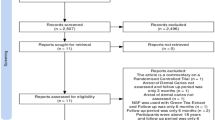Abstract
Data sources
The Cochrane Library, PubMed, Embase and the ISI Web of Science.
Study selection
English language clinical trials in children with outcome measures including the remineralisation or arresting effect of caries by professional fluoride treatment were considered.
Data extraction and synthesis
Two reviewers screened the studies and assessed risk of bias. Random effects meta-analysis was conducted.
Results
Seventeen studies were included, ten focused on remineralisation, seven on arresting carious lesions. Meta-analysis of four studies using 5% fluoride varnish found a 63.6% (95% CI; 36.0% – 91.2%) remineralisation of early enamel caries. For five studies using 38% silver diamine fluoride solution meta-analysis found 65.9% (95% CI; 41.2% – 90.7%) of caries arrested.
Conclusions
Professionally applied 5% sodium fluoride varnish shows the capability to remineralise early enamel caries in children. Silver diamine fluoride solution at 38% is effective in arresting active dentine caries. Because the number of clinical trials that studied the arresting effect of dental caries is limited, more clinical trials should be performed.
Similar content being viewed by others
Commentary
The paradigm shift in our understanding of the caries process necessitates its detection in continuum, that is, from earliest signs of demineralisation to deep cavitations.1 This early detection and the reversible nature of the caries process dictates the use of therapies that encourage remineralisation of early-enamel caries.2 Various strategies indicated for remineralisation of early caries lesions include use of fluorides, calcium and phosphate based products, antimicrobials and biofilm-modification etc.3 Use of fluoride is also indicated for arrest of dentinal lesions.
The present systematic review (SR) is a timely step that aims to evaluate the clinical efficacy of professionally applied fluorides (PAFs) in remineralising early enamel caries and arresting dentinal caries among children. The review has used PRISMA guidelines with a pre-defined research question. The search strategy is lucidly explained which aimed at looking for relevant studies from four different databases. Additional literature was also searched for by manually searching the bibliographies of relevant papers. However, there is no mention about efforts taken to find out about other ‘grey literature’ eg searching conference abstracts, hand searching of journals etc. Moreover the search strategy does not seem to be exhaustive enough to allow for retrieval of all the relevant literature and only English language literature was searched for, leading to language bias. Lastly, funnel plots were also not drawn to rule out possibility of publication bias.
Two authors were responsible for searching the literature and inclusion of studies for review, while a third investigator acted as referee. The search process finally led to inclusion of 17 articles in the review, including three publications identified from manual searching. Articles included were divided into two groups, ie studies that aimed at remineralisation of enamel caries (Group-1, ten studies) and arresting the dentin caries (Group-2, seven studies).
Among the ten studies that aimed for enamel remineralisation, different fluoride formulations were used – six studies investigated sodium fluoride varnish (NaF-V), two studies used fluoride gel, one with sodium fluoride gel while another used APF gel, one study used silicon tetra fluoride (SiF4), while one used 10% silver diamine fluoride. In group-2 out of seven included studies, six had used silver diamine fluoride (SDF) in varying concentrations while one used nano-silver fluoride.
Risk of bias (RoB) was assessed for all the studies using the Cochrane RoB tool. Only two studies in group-1 and one in group-2 were reported to have low RoB for allocation concealment. Most of the studies exhibited low RoB in ‘selective reporting’ domain (seven in group-1, all ten in group-2), but whether the authors retrieved the protocols or judged it from the outcome parameters used in the individual studies is unclear. Lastly, four studies in Group-1 and six in group-2 were reported to have low RoB in ‘blinding of outcome assessment’ domain.
For synthesising the results from the included studies meta-analysis of relatively homogenous studies in both the groups was conducted using random-effects model.
In group-1, four studies were included in meta-analysis that investigated NaF-V compared to either no treatment or some alternative therapies. For all these studies, initially the proportion of remineralised early enamel caries was calculated individually. Pooled estimate was in favour of NaF-V for remineralising enamel lesions (0.64, CI = 0.36 to 0.90). Two studies of NaF-V which were not included in the meta-analysis exhibited reduction in the overall percentage of early enamel caries and a significant reduction in the dimensions of early caries respectively. Apart from this, remineralisation effect of other fluoride agents, namely 0.9% SiF4 and 10% SDF could not be endorsed.
In group-2, five studies had used 38% sodium fluoride (44,800ppm F) in comparison with FV for arresting dentine caries with differing frequencies of application; wherein one study used the intervention agent as a one-off application, one with six-monthly applications, while the remaining three used it for annual application. In spite of the clinical heterogeneity present in terms of duration and frequency of application, type of dentition etc, all these studies were included in the meta-analysis. The heterogeneity was checked by calculating the I2 statistic (I2 = 96%, p <0.001%). Pooled-estimate was observed to be in favour of using 38% SDF to arrest dentine caries (0.66, C.I = 0.41 to 0.91).
From the results of meta-analysis and inferences from the results of studies not included in meta-analysis the authors concluded that professional application of NaF-V and 38% SDF can be effectively used for remineralisation of early enamel caries and arrest of dentin caries respectively. Two different SRs published recently have also echoed the results of this review, thus reconfirming the efficacy of NaF-V for remineralisation of early enamel caries and of SDF for arrest of dentin caries respectively.4, 5
As these reviews bring evidence in favour of using PAFs it will surely improve the confidence of both the cariologists who have always been supporting PAFs and clinicians who have to wield these strategies among their patients. The ultimate beneficiary will be humankind - with fewer ‘cavitations’ and better oral health. But still there is a need for more well-conducted trials for both building up the evidence and to justifiably conclude on the protocol of professional fluoride applications.
Practice points
-
Topical application of 5% sodium fluoride varnish is effective for remineralisation of early enamel caries among children.
-
Topical application of 38% silver diamine fluoride also seems to be an effective treatment for arrest of dentinal caries among children.
References
Pretty IA, Ellwood RP . The caries continuum: opportunities to detect, treat and monitor the re-mineralization of early caries lesions. J Dent 2013; 41:S12–21.
Cummins D . Dental caries: a disease which remains a public health concern in the 21st century--the exploration of a breakthrough technology for caries prevention. J Clin Dent 2013; 24 Spec no A:A1–14.
Ten Cate JM . Novel anticaries and remineralizing agents: prospects for the future. J Dent Res 2012; 91:813–815.
Lenzi TL, Montagner AF, Soares FZ, de Oliveira Rocha R . Are topical fluorides effective for treating incipient carious lesions?: A systematic review and meta-analysis. J Am Dent Assoc 2016; 147:84–91.
Contreras V, Toro MJ, Elías-Boneta AR, Encarnación-Burgos A . Effectiveness of silver diamine fluoride in caries prevention and arrest: a systematic literature review. Gen Dent 2017; 65:22–29.
Author information
Authors and Affiliations
Additional information
Address for correspondence: Chun-Hung Chu, Faculty of Dentistry, The University of Hong Kong, Hong Kong, China. E-mail: chchu@hku.hk
Gao SS, Zhang S, Mei ML, Lo EC, Chu CH. Caries remineralisation and arresting effect in children by professionally applied fluoride treatment – a systematic review. BMC Oral Health 2016; 16: 12. doi: 10.1186/s12903-016-0171-6.
Rights and permissions
About this article
Cite this article
Gugnani, N., Gugnani, S. Remineralisation and arresting caries in children with topical fluorides. Evid Based Dent 18, 41–42 (2017). https://doi.org/10.1038/sj.ebd.6401234
Published:
Issue Date:
DOI: https://doi.org/10.1038/sj.ebd.6401234



